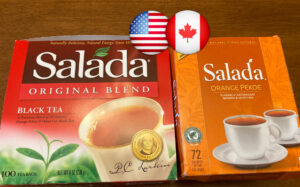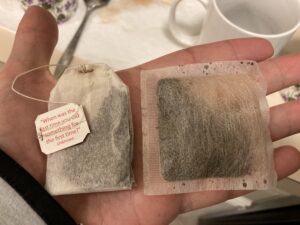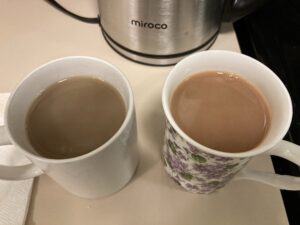Two teas with the same name, produced in different countries that share a border. How did we get to this point?
Salada tea was founded by Peter Larkin in 1892. The Montreal businessman pioneered the manufacture of reliable blended tea — packaged in foil and easy to distribute — as an alternative to the inconsistent loose tea commonly sold at the time (and gaining in popularity again today, but I digress.)
Salada’s popularity grew in Canada and parts of the United States where additional tea production plants were established to meet demand. The Salada tea enjoyed by Canadians and Americans was the same until 1988 when the Canadian operation was sold to Unilever while American production fell under Redco Foods, Inc.
Unilever produces the Salada and Red Rose brands in Canada while the Harris Tea Company is licensed to produce the Salada and Red Rose brands in the United States. I was eager to do a side-by-side comparison of the two teas.
The teabags are drastically different. Our Canadian friends are steeping their Salada tea in luxury with tagless, square-shaped, plant-based, renewable sachets — each with more tea quantity than the American version. US-based Salada drinkers will find a traditional tagged teabag with a twist: each tag comes with a written quote, typically words of wisdom.
The teas were steeped for three minutes using boiling water. Both were dark in color with the Canadian version exhibiting a more amber hue.
Salada USA had a sweet, floral fragrance. Salada Canada’s aroma was more pungent and earthy, with hints of sweet citrus, chocolate, and spice.
The USA version has a medium texture, sweet taste, and smooth finish. Tannin content is high in the Canadian kind, leading to a bitter mouth taste, and its body is stout.
Milk seems to compliment Salada Canada well. The casein from the milk tames the bitterness of the tannins resulting in an appealing color and satisfying cuppa.
Salada US, on the other hand, isn’t well suited for milk, which overwhelms the tea’s medium body and mild flavor.
If you prefer your mass-produced black tea with milk as I do, then go for Salada Canada. Salada USA is perfectly fine on its own or maybe with the addition of lemon or sweetener. I will use it for iced tea.
Now that we’ve reached the conclusion of this fun little exercise, one lingering question remains: as different as these Salada teas are, which version adheres more closely to the blend Peter Larkin created back in 1892? Could it be that both have strayed equally far from the original?
Video Transcript
Okay, today it’s Salada versus Salada. One is made in the United States by Harris Tea Co.
The other one is made in Canada, owned by Unilever.
So, these teas actually share a similar history or the same history. They were born in I believe in Montreal,
[Places tea bags into mugs – Salada USA on the left, Salada Canada on the right]
became a popular tea brand, but at some point,
they split. There was a Canadian operation and a US operation and ultimately they were …
now they’re owned by different companies, and we’ll see how they stack up against each other.
I’m going to brew [steep, actually] each of them for three minutes
[Kettle is turned on]
[Boiling water from the kettle is poured into both mugs]
[A timer set for 3 minutes is started and counts down to 2 minutes, 54 seconds]
[Transistion to the timer counting down from 3 seconds until ends and makes a beeping noise]
[The tea bags are removed from each mug]
Okay, so the one on the left is the American or the United States, and …
the one on the right is Canada. I’m going to try both of them, first without milk.
Usually, I like to put milk in my black tea but I’m going to try them both plain so here’s the Canadian
[Takes a sip from the mug on the right (Salada Canada)]
That one’s pretty good. It has a little bit of a tannic bite.
[Pickups up the mug on the left and takes a sip of Salada USA]
[Places mug back on the counter]
This one’s tasty as well but definitely not as …
definitely not as strong on this one. So now I’m gonna try them with milk.
[Pours milk into both mugs]
[Takes a spoon and stirs milk in both mugs]
Okay, one thing i forgot to mention looking at them without milk I thought that the USA one …
had a little bit of a darker color, whereas the Canadian one had a little bit of an amber color.
And now that I pour milk in them I see that the Canadian one definitely stands up better to milk …
… and the USA one probably has a … not as heavy of a body as the Canadian one.
So I’m going to try both of them now. I mean you can tell by the color of the USA one that …
… it just doesn’t stand up to milk very well. Here we go.
[Lifts mug on the right and sips Salada Canada with milk]
That’s good.
[Lifts the mug on the left to sip Salada USA with milk]
Not bad, but I think I’d go with the Canadian one.
So just to wrap up …
… my preference is for this one [points to the Salada Canada package] the one made in Canada.
It stands up to milk better, and when I drink a bagged black tea I expect …
… it to stand up to milk and I like it with milk, so …
This is the one I’d go with, and if you’re in the United States, you can order it on Amazon.
Salada USA, I think I’m going to use this one for iced tea.
So there you go: Salada versus Salada



